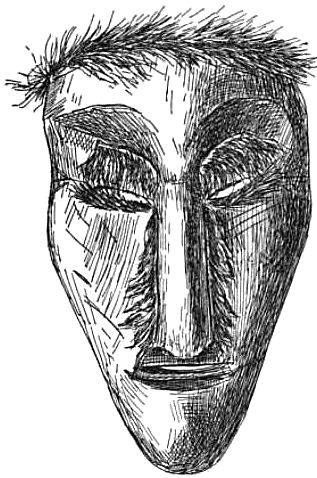Indian Masks - Their Role in Native American Culture
Indian or Native American masks were made for ceremonies, decoration, war rituals, shaman rituals, rituals initiating young man into the tribe, in healing rituals, in entertainment, given as gifts and spiritual rituals. Masks could be made for a ceremony where one chief of one tribe gives gifts to a chief from another tribe. Native Americans believed that the person wearing a mask was taken over by the spirit that mask represents.
In tribe usually, a male of high status, with a lot of skill, makes the masks in isolation. Mask represent a characteristic or an animal and is decorated with paint, feathers, fur, straw, leather, or leaves. Trained dancers would wear the masks and perform legend stories.

At first, masks were made using traditional tools for shaping, like bone and rock, but after the arrival of Europeans, Native Americans started using new tools for better precision.
Women and children were allowed to watch the ceremony as entertainment but were not allowed to know the meaning of the mask and the story told. Rituals could be limited to only certain members of the tribe.
The chief of the tribe wears the most powerful mask of an eagle.
Native American masks can represent:
- characteristic
- portrait – represents a certain person
- status
- spirit
- animal – clan descended from some animal
Masks could be:
- single – from a single piece of wood
- mechanical – with moveable parts, like eyes open and shut
- transformational – when closed one mask it could reveal another mask
Meaning of the mask's colors is:
- red – represents happiness and faith
- yellow and orange – represents intellect
- green – represents healing, harmony, and nature
- purple – represents mystery and magic
- black – represents victory and success
- white – represents light and purity
- blue – represents intuition and wisdom
Kwakwaka’wakw tribe live in British Columbia on northern Vancouver Island. Their masks were an important part in dance, and it represented a character conveyed by the dancer. They have masks like Hamatsa (raven-cannibal), Sun Mask, Moon mask, etc.
Pueblos is Native American community of tribes: Hopi, Zuni, Laguna Pueblo, Acoma Pueblo and Tewa Village. Kachinas are spirits and representations of things in the real world, from ancestor to natural elements. They can have humanlike features, like have children. They can bring health, protection, fertility, good luck, etc. These people make masks representing all kind of kachinas for ritual dances, made from fur, feathers, leather, or leaves. They are supernatural beings making a line between mortals and gods in everyday things. These spirits are impersonated during ceremonial dances by a man dressed up in mask and costume. They believe that they lost their identity and kachina spirit takes over.
Iroquois are Native American confederacy of tribes: Mohawk, Seneca, Cayuga, Tuscarora, Oneida, and Onondaga. They made wooden “false face” masks. These masks were used in healing rituals, invoking the spirit of an old hunch-backed man offering him tobacco and corn mush. The invoke being will protect people from illness and fierce winds. The man who is making the mask is guided by this spirit to find the right wood in the forest for the mask. The mask is carved on the living tree and is removed when finished, so it is considered to be a living representation of a spirit. When the mask is not worn, it is treated as living being. People who were cured could become members of The False Face Society. The mask is painted black and red, has a bent nose, deep set eyes accented by metal, hair and tobacco tied above the forehead. The ritual is done twice a year, in spring and fall. People go with this mask through the community to chase off evil spirits and diseases. If someone is sick tobacco is burned, and wood ashes are thrown over him.
